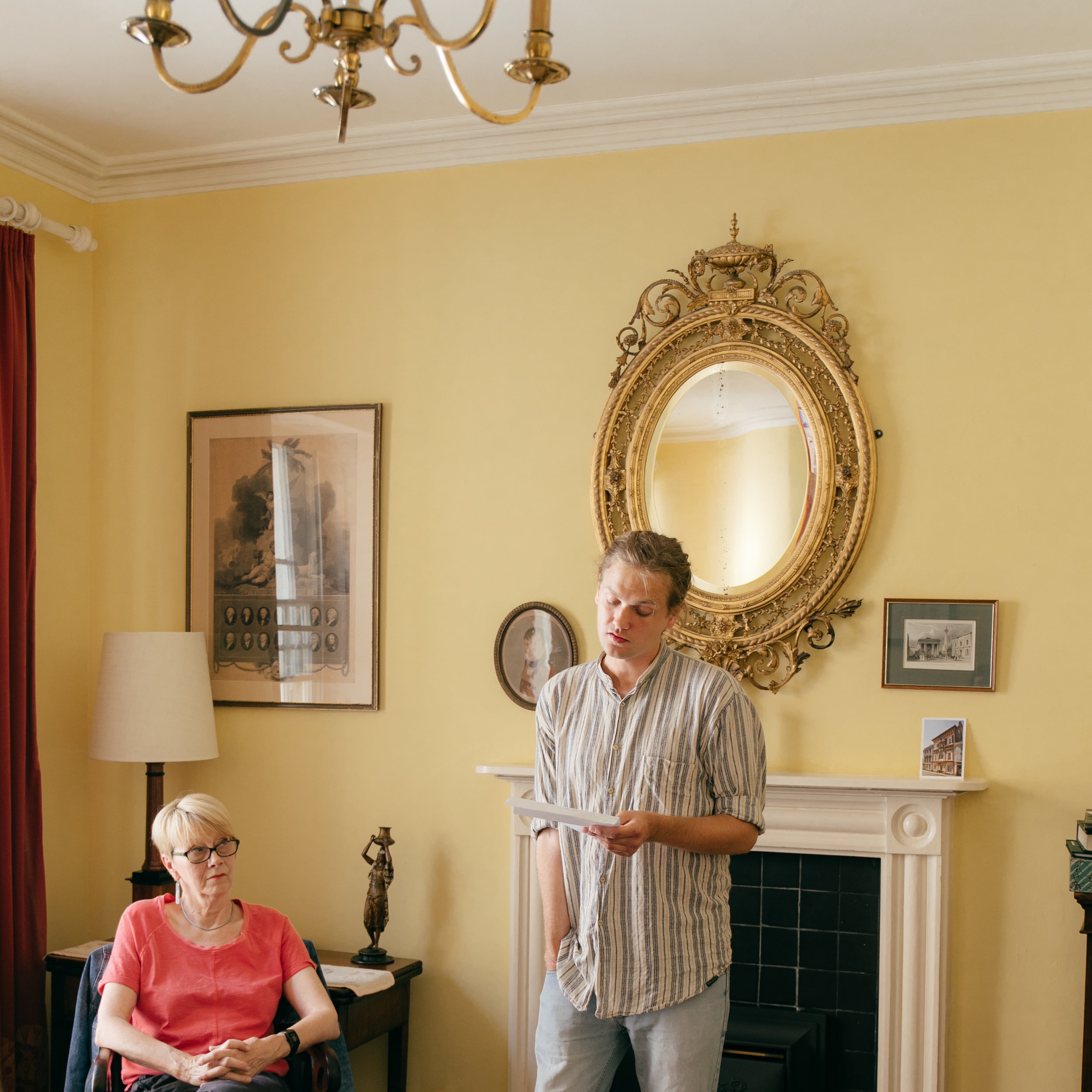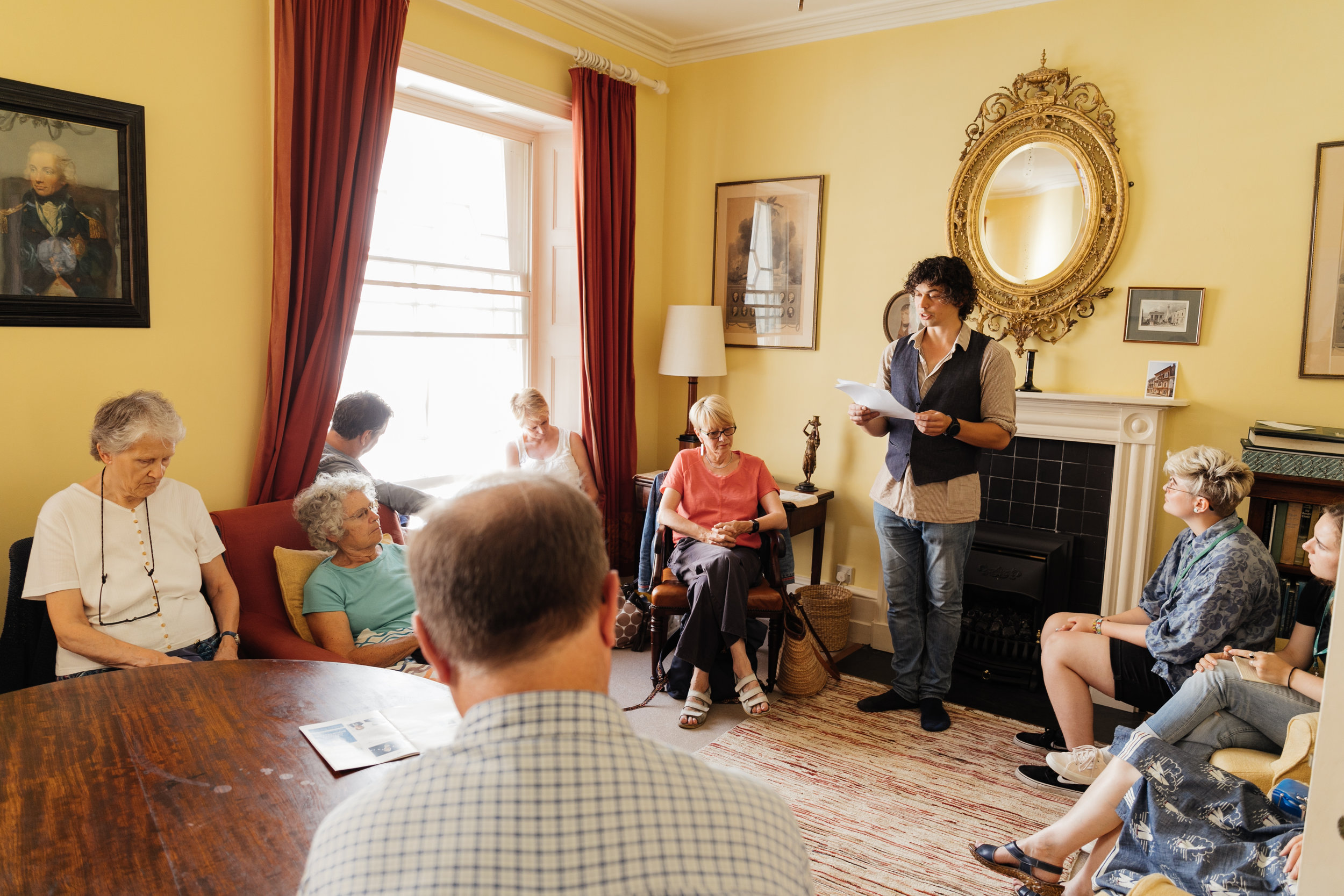Egyptian Houses: Interview with David Devanny, Andrew Fentham & Jerome Fletcher
Egyptian Houses was an installation and series of readings that took place in the intimate setting of the Egyptian House during the Penzance Literary Festival this summer. Following the Litfest, I spoke to David, Andrew and Jerome about what inspired their performance, and what we can learn from the Egyptian House.
photos copyright Laura Bailey 2017
GW: How was the project conceived, and how did you come together for it?
AF: The project was conceived as a direct response this year's Penzance LitFest theme: 'Uncharted Waters'. David and I had previously been fascinated by the architecture of Penzance's Egyptian House (1835-36). A conversation with Jerome, who is based in Plymouth, revealed that there was a building there (1823) with a similar façade in which he was already interested.
GW: What is the significance of the Egyptian House to Penzance, and to Cornwall?
AF: Nikolaus Pevsner calls the Egyptian House in Penzance 'the outstanding C19 survival of Egyptianizing commercial architecture in Britain'. The building is architecturally interesting and invokes a number of histories worth unpacking and with direct relevance to Cornwall's commercial and naval contexts.
JF: There is also an Egyptian house in Plymouth. It is an Oddfellows hall, a sort of social club and is not in a good state of repair. Nothing like as good as the Penzance house. Obviously because Plymouth is a big naval town it was/is massively connected to Nelson and in particular his victory at the battle of the Nile in 1798.
GW: How did the Egyptian House influence your decisions, and did you draw from the wider context of mythology and culture?
AF: The site-specificity of project meant that all decisions were influenced by the Egyptian House, from practicalities of hosting the event to the content of the texts. We drew upon ancient Egyptian mythology and culture but strictly through a lens of the lasting effects of colonialism.
GW: You talked about the influence of Colonialism – was that always present in your mind when you were preparing for the reading?
DD: Yes, definitely, and we all talked carefully about how we could deliver the project sensitively given the context. The Egyptian House is a gem and very captivating, but it's also anachronistic and iconic of a century of cultural exchange which involved a very one-sided power dynamic. It was refreshing to discover that this historical complexity was directly addressed in the interior décor by the Landmark Trust, which functions almost as a de-colonial hypertext reaching out to a range of cultural histories.
GW: What is it about Egyptian culture and its decadence that attracts people to it, and attracted you?
JF: Decadents, especially the 19th century European decadents, were not so much attracted to Egyptian culture per se, but to two aspects of it. Firstly, its excesses and its lavish richness. (You see some of this in the bright colours and exotic architecture of the Egyptian house). But more importantly they were attracted to its decline. They were fascinated by the extent to which this once great culture had degenerated. They had an unhealthy interest in the degenerate and ruined. It was a perverse response to prevalence of notions of progress and perfectibility; a rebellion against the optimism of much 19th century economic and social positivism.
GW: Were there aspects about the house or its context that immediately stood out to you as needing to be addressed?
AF: The first question to present itself upon one's stumbling upon the Egyptian House in Penzance is 'why'? Why this? Why here? That initial 'why' led to an investigation of Egyptian revival decorative arts and an examination of the connected aspects of colonialism, appropriation, pastiche, etc.
GW: What is the importance of location to a text, especially to readings and installations?
AF: Much of our text was site-specific. Readings and installations necessarily adapt or respond to location. Our text was anchored in the performance space which happened to be small - hopefully this lent an intimacy.
JF: Location, in the broad sense of ‘site’, and under that I would include the page, is of huge importance to the reception of any text. Before you start reading, the site is doing some of the signifying work for you. It is a frame which sets up expectations in the mind of the listener. Those expectations can then be met or not, both in positive and negative ways. All texts are embedded in contexts, and the site is part of the context. Its importance cannot be overstated.
GW: Is location something that you've used as a focal point before in your writing?
AF: Absolutely. As well as writing about place, we have (separately and together) written site-specific performances and installations for galleries, pubs, museums and heritage sites, and walks through urban, rural and conceptual places.
GW: How effective do you think literature, especially poetry, is as a medium of response and commentary?
DD: Ah, this is a huge question! But I think response and commentary is what literature does especially well. For me one of the functions of literature is to create a space for the exploration of new ideas and reviewing existing solutions; poetry specifically is a forum for the production of new language and a testing ground for existing formations.
GW: What are the challenges of writing what is going to be read aloud, or transposing the written to the oral?
AF: Speaking for myself - reading aloud-in-the-head, or by a low muttering, is anyway how I would compose the rhythm of a 'page poem' or prose piece. Beyond issues of rendering visually-inclined writing into speech, there don't seem to be any challenges of transposition.
GW: Why do you think listening appeals to an audience, as opposed to reading?
DD: Contrary to what we might have expected to be the outcome of new media we find ourselves now in an image laden world surrounded by textual information. As well as the appeal of liveness and performance, engagement with the human voice and more generally the world of the acoustic, offers an appealing communion and connection with very ancient traditions. Sound is physical and intimate.
JF: Being read to is one of the earliest contacts we have with a structured text, one which engaged with something more than a simple communication. It is like being given a gift, and ranks alongside such gifts as being provided with a meal. An audience ‘receives’ a spoken text. It is/should be a generous gesture and understood as such.
GW: What was it like for you, reading to a small audience in such an intimate setting?
AF: Reading to a smaller audience always feels preferable. In this case I hope the audience felt able to examine the detail of the setting which had informed the text.
DD: For me there are pros and cons to audience size and setting. In work which is more self-consciously a performance rather than a reading, affect is constructed collaboratively between reader, audience, medium and location. Trying to manage all of the relevant contexts to get the right energy in the room is crucial; I think the readings at the Egyptian House were lovely though, as there was a strong sense that everybody was pleased to be in the space.
JF: It was a very relaxed atmosphere, I thought. With the audience that close to the performers we didn’t have to work hard to get the text across. Because it was effectively a sitting room, I think the audience felt more relaxed too. Because part of the attraction of the reading was the building, I suspect most of the listeners were already looking for the connection between what we were saying and the space itself.
Thanks go to the Penzance Literary Festival for organising the events, and to the Landmark Trust for the use of the Egyptian House in Penzance, which they maintain.
For more information on the Penzance Literary Festival please visit: http://www.pzlitfest.co.uk
For more information on the Landmark Trust and their properties please visit: https://www.landmarktrust.org.uk
by Gabby Willcocks



